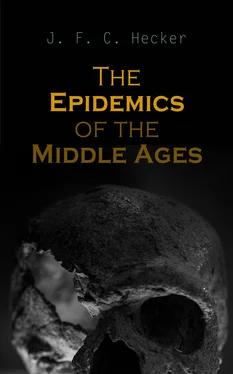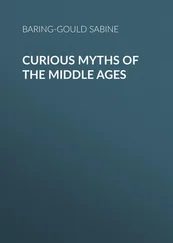On this side, therefore, such a point of view is not to be found, if we would not lose ourselves in the wilderness of conjectures, of which the world is already too full: but it may be found in the ample and productive field of historical research.
History—that mirror of human life in all its bearings, offers, even for general pestilences, an inexhaustible, though scarcely explored, mine of facts; here too it asserts its dignity, as the philosophy of reality delighting in truth.
It is conformable to its spirit to conceive general pestilences as events affecting the whole world—to explain their phenomena by the comparison of what is similar. Thus the facts speak for themselves, because they appear to have proceeded from those higher laws which govern the progression of the existence of mankind. A cosmical origin and convulsive excitement, productive of the most important consequences among the nations subject to them, are the most striking features to which history points in all general pestilences. These, however, assume very different forms, as well in their attacks on the general organism, as in their diffusion; and in this respect a development from form to form, in the course of centuries, is manifest, so that the history of the world is divided into grand periods in which positively defined pestilences prevailed. As far as our chronicles extend, more or less certain information can be obtained respecting them.
But this part of medical history, which has such a manifold and powerful influence over the history of the world, is yet in its infancy. For the honour of that science which should everywhere guide the actions of mankind, we are induced to express a wish, that it may find room to flourish amidst the rank vegetation with which the field of German medical science is unhappily encumbered.
CHAPTER I.
GENERAL OBSERVATIONS.
Table of Contents
That Omnipotence which has called the world with all its living creatures into one animated being, especially reveals himself in the desolation of great pestilences. The powers of creation come into violent collision; the sultry dryness of the atmosphere; the subterraneous thunders; the mist of overflowing waters, are the harbingers of destruction. Nature is not satisfied with the ordinary alternations of life and death, and the destroying angel waves over man and beast his flaming sword.
These revolutions are performed in vast cycles, which the spirit of man, limited, as it is, to a narrow circle of perception, is unable to explore. They are, however, greater terrestrial events than any of those which proceed from the discord, the distress, or the passions of nations. By annihilations they awaken new life; and when the tumult above and below the earth is past, nature is renovated, and the mind awakens from torpor and depression to the consciousness of an intellectual existence.
Were it in any degree within the power of human research to draw up, in a vivid and connected form, an historical sketch of such mighty events, after the manner of the historians of wars and battles, and the migrations of nations, we might then arrive at clear views with respect to the mental development of the human race, and the ways of Providence would be more plainly discernible. It would then be demonstrable, that the mind of nations is deeply affected by the destructive conflict of the powers of nature, and that great disasters lead to striking changes in general civilization. For all that exists in man, whether good or evil, is rendered conspicuous by the presence of great danger. His inmost feelings are roused—the thought of self-preservation masters his spirit—self-denial is put to severe proof, and wherever darkness and barbarism prevail, there the affrighted mortal flies to the idols of his superstition, and all laws, human and divine, are criminally violated.
In conformity with a general law of nature, such a state of excitement brings about a change, beneficial or detrimental, according to circumstances, so that nations either attain a higher degree of moral worth, or sink deeper in ignorance and vice. All this, however, takes place upon a much grander scale than through the ordinary vicissitudes of war and peace, or the rise and fall of empires, because the powers of nature themselves produce plagues, and subjugate the human will, which, in the contentions of nations, alone predominates.
Table of Contents
The most memorable example of what has been advanced, is afforded by a great pestilence of the fourteenth century, which desolated Asia, Europe, and Africa, and of which the people yet preserve the remembrance in gloomy traditions. It was an oriental plague, marked by inflammatory boils and tumours of the glands, such as break out in no other febrile disease. On account of these inflammatory boils, and from the black spots, indicatory of a putrid decomposition, which appeared upon the skin, it was called in Germany and in the northern kingdoms of Europe, the Black Death , and in Italy, la Mortalega Grande, the Great Mortality 4.
Few testimonies are presented to us respecting its symptoms and its course, yet these are sufficient to throw light upon the form of the malady, and they are worthy of credence, from their coincidence with the signs of the same disease in modern times.
The imperial writer, Kantakusenos 5, whose own son, Andronikus, died of this plague in Constantinople, notices great imposthumes 6of the thighs and arms of those affected, which, when opened, afforded relief by the discharge of an offensive matter. Buboes, which are the infallible signs of the oriental plague, are thus plainly indicated, for he makes separate mention of smaller boils on the arms and in the face, as also in other parts of the body, and clearly distinguishes these from the blisters 7, which are no less produced by plague in all its forms. In many cases, black spots 8broke out all over the body, either single, or united and confluent.
These symptoms were not all found in every case. In many, one alone was sufficient to cause death, while some patients recovered, contrary to expectation, though afflicted with all. Symptoms of cephalic affection were frequent; many patients became stupified and fell into a deep sleep, losing also their speech from palsy of the tongue; others remained sleepless and without rest. The fauces and tongue were black, and as if suffused with blood; no beverage would assuage their burning thirst, so that their sufferings continued without alleviation until terminated by death, which many in their despair accelerated with their own hands. Contagion was evident, for attendants caught the disease of their relations and friends, and many houses in the capital were bereft even of their last inhabitant. Thus far the ordinary circumstances only of the oriental plague occurred. Still deeper sufferings, however, were connected with this pestilence, such as have not been felt at other times; the organs of respiration were seized with a putrid inflammation; a violent pain in the chest attacked the patient; blood was expectorated, and the breath diffused a pestiferous odour.
In the West, the following were the predominating symptoms on the eruption of this disease 9. An ardent fever, accompanied by an evacuation of blood, proved fatal in the first three days. It appears that buboes and inflammatory boils did not at first come out at all, but that the disease, in the form of carbuncular ( anthraxartigen ) affection of the lungs, effected the destruction of life before the other symptoms were developed.
Thus did the plague rage in Avignon for six or eight weeks, and the pestilential breath of the sick, who expectorated blood, caused a terrible contagion far and near; for even the vicinity of those who had fallen ill of plague was certain death 10; so that parents abandoned their infected children, and all the ties of kindred were dissolved. After this period, buboes in the axilla and in the groin, and inflammatory boils all over the body, made their appearance; but it was not until seven months afterwards that some patients recovered with matured buboes, as in the ordinary milder form of plague.
Читать дальше










